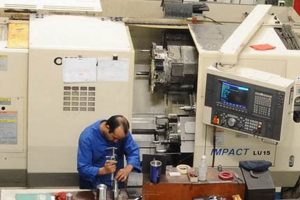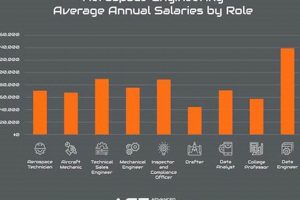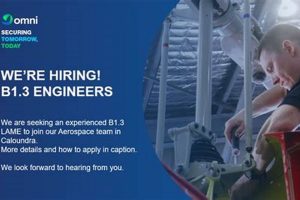The availability of positions for professionals specializing in the structural integrity of aircraft and spacecraft within the United States is a significant aspect of the aerospace industry. These roles focus on analyzing and mitigating potential failures due to stress, strain, and other environmental factors impacting flight vehicles. A typical example involves calculating the load-bearing capacity of a wing component to ensure it can withstand the forces experienced during flight maneuvers.
Securing these types of positions is vital for ensuring the safety and reliability of aerospace systems. The work contributes directly to preventing catastrophic failures and optimizing the performance and lifespan of aircraft and spacecraft. Historically, demand for these skilled engineers has been linked to periods of increased activity in the aerospace sector, including government-funded research and development, commercial aircraft production, and space exploration initiatives.
Understanding the qualifications, responsibilities, compensation, and geographic distribution associated with these engineering career opportunities in the United States is crucial for both job seekers and those interested in the health of the aerospace industry.
This section provides guidance for individuals pursuing careers focused on evaluating the structural integrity of aircraft and spacecraft within the United States. Success in this field requires a combination of technical expertise and strategic career planning.
Tip 1: Acquire a Strong Educational Foundation: A bachelor’s degree in aerospace, mechanical, or civil engineering is generally required, with advanced degrees (master’s or Ph.D.) often preferred for specialized roles and research positions. Focus on coursework related to finite element analysis, structural mechanics, and materials science.
Tip 2: Develop Proficiency in Relevant Software: Familiarity with industry-standard software packages such as ANSYS, Nastran, and Abaqus is essential. Practical experience using these tools for modeling and simulation of stress and strain is highly valued.
Tip 3: Gain Practical Experience Through Internships: Seek internship opportunities with aerospace companies or government research laboratories to gain hands-on experience in structural analysis and testing. These experiences provide valuable networking opportunities and enhance your resume.
Tip 4: Understand Industry Standards and Regulations: Become knowledgeable about relevant industry standards and regulations, such as those established by the FAA (Federal Aviation Administration) and NASA. Compliance with these standards is critical for ensuring safety and reliability.
Tip 5: Network with Industry Professionals: Attend industry conferences, join professional organizations (e.g., AIAA, ASME), and connect with engineers on platforms like LinkedIn. Networking can provide valuable insights into job opportunities and industry trends.
Tip 6: Tailor Your Resume and Cover Letter: Highlight relevant skills and experiences in your resume and cover letter, emphasizing your expertise in structural analysis, finite element modeling, and materials science. Quantify your accomplishments whenever possible.
Tip 7: Consider Geographic Location: Aerospace industry employment is often concentrated in specific geographic regions, such as California, Washington, Texas, and Florida. Be prepared to relocate to areas with a higher concentration of opportunities.
Adhering to these guidelines can significantly improve the likelihood of securing structural engineering positions within the aerospace sector. A proactive approach to education, skill development, and networking is crucial for career advancement.
The subsequent sections will explore specific company profiles and compensation expectations associated with these specialized engineering roles.
1. Structural Analysis Expertise
Structural analysis expertise forms the bedrock of roles within the aerospace sector concerned with assessing the integrity and safety of aircraft and spacecraft. This expertise directly correlates with the availability and requirements of “aerospace stress engineer jobs usa.” A strong foundation in structural analysis allows engineers to predict how aircraft components will behave under various loads and environmental conditions. The consequence of lacking this expertise is the potential for catastrophic failures, making it an indispensable skill for ensuring flight safety. For example, engineers utilize structural analysis to determine the optimal thickness and material composition of wing structures to withstand aerodynamic forces during flight, a task directly relevant to “aerospace stress engineer jobs usa”.
Furthermore, structural analysis expertise is crucial for optimizing designs and reducing material costs. By accurately simulating stress distributions, engineers can identify areas where material can be removed without compromising structural integrity. This optimization process directly impacts the economic viability of aerospace projects. Consider the design of a spacecraft pressure vessel; precise structural analysis can minimize the required wall thickness, reducing weight and launch costs. Thus, possessing advanced skills in structural analysis increases an engineer’s value in the job market, specifically within the sphere of “aerospace stress engineer jobs usa.”
In summary, structural analysis expertise is not merely a desirable skill but a fundamental requirement for many “aerospace stress engineer jobs usa”. It impacts flight safety, design optimization, and cost efficiency. Challenges exist in keeping pace with evolving technologies and analytical methods, underscoring the need for continuous learning and professional development within this critical field. The availability of competent professionals with this expertise directly supports the growth and innovation of the U.S. aerospace industry.
2. Finite Element Modeling
Finite Element Modeling (FEM) constitutes a core competency within “aerospace stress engineer jobs usa.” Its application allows engineers to simulate and analyze the structural behavior of aircraft and spacecraft components under various loading conditions. The direct correlation lies in the ability of FEM to predict stress concentrations, deformation patterns, and potential failure points before physical prototypes are constructed. This predictive capability is indispensable for ensuring the safety and reliability of aerospace vehicles. For instance, an engineer might use FEM to assess the impact of aerodynamic loads on an aircraft wing, simulating flight conditions to identify areas susceptible to fatigue or cracking.
The implementation of FEM methodologies directly affects design optimization and cost reduction. Through iterative simulations, engineers can refine designs to minimize weight and maximize structural efficiency. This process often involves evaluating alternative materials and configurations using FEM software to determine the most suitable solution for a given application. Consider the design of a spacecraft heat shield; FEM is crucial for simulating the thermal stresses induced during atmospheric reentry, allowing engineers to select appropriate materials and design features to withstand extreme temperatures. The results obtained from FEM analyses directly inform critical design decisions, influencing the performance and longevity of aerospace components.
In summary, FEM serves as a vital tool for professionals in “aerospace stress engineer jobs usa,” enabling them to perform detailed structural analyses and design optimizations. The accuracy and reliability of FEM simulations are paramount for ensuring the safety and performance of aircraft and spacecraft. Challenges remain in the validation of FEM models and the accurate representation of complex material behaviors; however, ongoing advancements in computational power and modeling techniques continue to enhance the utility and precision of FEM in the aerospace industry. The demand for engineers skilled in FEM remains strong, reflecting the ongoing need for advanced simulation capabilities in the design and development of aerospace systems.
3. Materials Science Knowledge
Materials science knowledge is a foundational requirement for roles within “aerospace stress engineer jobs usa.” The ability to select and apply appropriate materials, considering their mechanical, thermal, and chemical properties, directly impacts the structural integrity and performance of aircraft and spacecraft. Stress engineers must understand how different materials behave under stress, strain, and varying temperatures to accurately predict the lifespan and reliability of components. For example, the selection of titanium alloys for aircraft engine components requires a deep understanding of their high strength-to-weight ratio and resistance to fatigue at elevated temperatures. Failure to account for material properties can lead to premature failure and catastrophic consequences.
The practical application of materials science principles extends to various aspects of aerospace engineering, including composite materials, corrosion prevention, and joining techniques. Stress engineers utilize their understanding of materials to design structures that minimize weight while maximizing strength and durability. They also consider the long-term effects of environmental factors, such as radiation exposure in space environments, on material properties. In the development of a spacecraft’s thermal protection system, engineers leverage materials science to select heat-resistant materials capable of withstanding extreme temperatures during atmospheric re-entry, ensuring the safety of the spacecraft and its occupants.
In summary, materials science knowledge is an indispensable component of “aerospace stress engineer jobs usa.” It underpins the ability to design safe, reliable, and efficient aerospace structures. Continuous advancements in materials technology, such as the development of advanced composites and nanomaterials, necessitate ongoing learning and adaptation for stress engineers. The increasing complexity of aerospace systems demands a comprehensive understanding of material behavior to ensure optimal performance and longevity.
4. Regulatory Compliance Adherence
Regulatory compliance adherence is a non-negotiable aspect of positions within “aerospace stress engineer jobs usa.” These roles demand a thorough understanding and application of industry regulations and standards to ensure the safety and airworthiness of aircraft and spacecraft. Strict compliance is critical due to the potential consequences of non-compliance, which can range from financial penalties to catastrophic failures.
- FAA Regulations and Certification
The Federal Aviation Administration (FAA) sets forth stringent regulations regarding aircraft design, manufacturing, and operation. Stress engineers must ensure that all structural analyses and designs meet FAA requirements for certification. This includes demonstrating that the aircraft can withstand specified loads and environmental conditions. Non-compliance can result in the denial of certification, rendering the aircraft unable to operate commercially.
- NASA Standards for Spaceflight
For positions involving spacecraft design, adherence to NASA standards is paramount. These standards cover various aspects of structural integrity, including materials selection, load analysis, and risk assessment. NASA mandates rigorous testing and analysis to ensure the safety and reliability of spaceflight hardware. Engineers are responsible for documenting compliance with these standards throughout the design and development process.
- Industry-Specific Standards (e.g., AS9100)
Beyond government regulations, aerospace companies often adhere to industry-specific standards, such as AS9100, which defines quality management system requirements. These standards ensure consistent processes and procedures throughout the organization, promoting a culture of quality and compliance. Stress engineers must understand and follow these standards in their work, contributing to the overall quality and reliability of aerospace products.
- Documentation and Traceability
Maintaining comprehensive documentation is essential for demonstrating compliance with regulations and standards. Stress engineers are responsible for documenting all analyses, calculations, and test results. This documentation must be traceable to specific requirements and design decisions. Proper documentation facilitates audits and reviews by regulatory agencies, providing evidence of compliance and ensuring accountability.
In summary, regulatory compliance adherence is an intrinsic element of “aerospace stress engineer jobs usa.” The roles demand a commitment to upholding the highest standards of safety and quality. Failure to comply with regulations can have severe consequences, underscoring the importance of thorough knowledge, meticulous documentation, and a proactive approach to ensuring compliance throughout the design and development lifecycle. The ongoing evolution of regulations requires continuous professional development to stay abreast of the latest requirements.
5. Geographic Location Relevance
The concentration of “aerospace stress engineer jobs usa” is heavily influenced by geographic location. The presence of major aerospace manufacturers, government research facilities, and military installations creates regional hubs with significantly higher demand for these specialized engineering roles.
- California’s Aerospace Dominance
California, particularly Southern California, has a long-standing history as a center for aerospace innovation and manufacturing. The presence of companies like Boeing, SpaceX, Northrop Grumman, and Lockheed Martin, along with government facilities like NASA’s Jet Propulsion Laboratory, generates a substantial number of opportunities. This concentration attracts a highly skilled workforce and fosters a competitive job market.
- Washington State’s Commercial Aviation Hub
Washington State, anchored by Boeing’s commercial airplane division, represents another significant geographic cluster. The region’s focus on aircraft production and related technologies creates specialized demand for stress engineers with expertise in airframe design and analysis. The presence of numerous suppliers and subcontractors further amplifies the need for these engineering roles.
- Texas’ Expanding Aerospace Sector
Texas is emerging as a growing aerospace hub, driven by factors such as lower operating costs and a favorable business climate. Companies like Lockheed Martin, Blue Origin, and SpaceX have expanded their operations in Texas, leading to increased demand for stress engineers. The state’s geographical advantages for spaceport development further contribute to its growing importance in the aerospace industry.
- Florida’s Space Coast
Florida’s “Space Coast,” home to Kennedy Space Center and Cape Canaveral Space Force Station, maintains a critical role in space launch and exploration. This region provides opportunities for stress engineers specializing in launch vehicle design, structural testing, and mission support. The ongoing growth of commercial space activities is expected to further stimulate demand in this area.
The geographic distribution of “aerospace stress engineer jobs usa” is therefore not uniform. Prospective candidates should strategically consider these regional concentrations to maximize their career prospects. Understanding the specific strengths and specializations of aerospace hubs can help engineers target their job search and tailor their skillsets to meet local demands.
Frequently Asked Questions
This section addresses common inquiries regarding career opportunities in structural analysis and related fields within the United States aerospace industry.
Question 1: What educational qualifications are typically required for these engineering roles?
A bachelor’s degree in aerospace engineering, mechanical engineering, or a closely related field is generally the minimum requirement. Many positions, particularly those involving research and development, may require a master’s degree or doctorate. Coursework should emphasize structural mechanics, finite element analysis, and materials science.
Question 2: Which software skills are most valued by employers in this field?
Proficiency in industry-standard software packages such as ANSYS, NASTRAN, Abaqus, and HyperMesh is highly desirable. Experience with CAD software like CATIA or SolidWorks can also be beneficial. The specific software requirements may vary depending on the employer and the nature of the work.
Question 3: What are the typical responsibilities associated with positions of this nature?
Responsibilities generally include performing structural analyses on aircraft or spacecraft components, creating finite element models, interpreting analysis results, and making recommendations for design improvements. Engineers may also be involved in testing, validation, and failure analysis.
Question 4: What is the expected salary range for these engineering positions in the United States?
Salaries vary based on experience, education, location, and the specific employer. Entry-level positions may offer salaries in the range of $70,000 to $90,000 per year, while experienced engineers with advanced degrees can earn significantly more, often exceeding $120,000 annually.
Question 5: Which industries commonly employ stress engineers with aerospace expertise?
Major employers include aerospace manufacturers (e.g., Boeing, Lockheed Martin, SpaceX), government agencies (e.g., NASA, Department of Defense), and engineering consulting firms specializing in aerospace. Opportunities also exist in the commercial aviation sector and related industries.
Question 6: How can one enhance their prospects of securing such a role?
Gaining relevant experience through internships or research projects is highly recommended. Developing strong analytical and problem-solving skills is crucial. Networking with industry professionals and staying abreast of the latest advancements in structural analysis and materials science can also improve job prospects.
In conclusion, career opportunities in aerospace structural integrity engineering are available to qualified individuals. Preparation and knowledge are crucial to take advantage of them.
The following section delves into strategies for career advancement within the field.
Conclusion
The examination of positions within the United States concerning structural analysis of flight vehicles has revealed the confluence of specialized skills, rigorous regulatory standards, and geographically concentrated opportunities. Mastering finite element modeling, acquiring comprehensive materials science knowledge, and maintaining unwavering regulatory compliance emerge as critical attributes for success in this field. The analysis demonstrates that these are not merely desirable qualities, but fundamental prerequisites for navigating and excelling in “aerospace stress engineer jobs usa”.
Given the continued demand for safer, more efficient, and more reliable aerospace systems, the role of the stress engineer remains vital. Aspiring and practicing engineers are encouraged to relentlessly pursue expertise, remain adaptable to evolving technologies and standards, and strategically consider geographic factors to maximize their impact in this crucial sector. The sustained advancement of air and space travel depends on their expertise.







